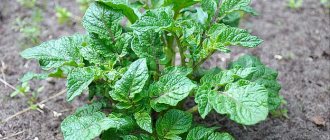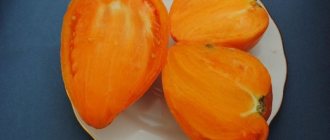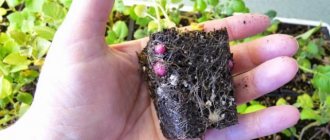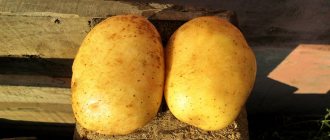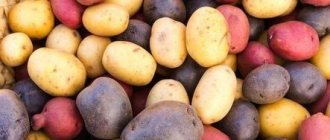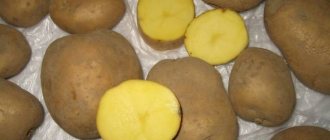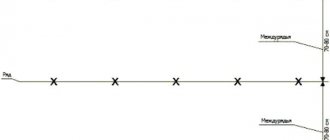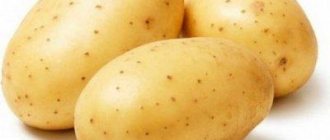If you love exotic things, you will probably like the unusual Sineglazka potato variety. The tubers have blue spots on the skin, which gives them charm and zest. Unfortunately, the variety has not received recognition from agronomists, but gardeners have become very fond of Sineglazka and continue to grow it. To learn more about this unusual variety, we suggest studying its description, characteristics and photos with reviews from gardeners who know Sineglazka first-hand.
Description of the potato variety Sineglazka
The Sineglazka potato variety was bred in the 50s of the 20th century. Its author was S.I. Domin, who worked at the Institute for the Study of Starch Products. During breeding, wild and cultivated potato species were crossed. The new hybrid received the number 15555. It was tested in different climatic regions.
The Sineglazka potato has taken root well in small gardens. On an industrial scale, the variety showed low shelf life, but became popular among gardeners. It is grown in the Moscow region, Smolensk and Kaluga regions. The hybrid got its name thanks to the bright blue eyes that stand out on the pink-white peel.
According to the description of the variety, the Sineglazka potato is a spreading large bush. The stems are strong and produce many dark green leaves. The flowers are light blue, there are few of them. The root system is developed.
The tubers are large, oval or round, slightly flattened. The average weight of root vegetables is from 70 to 150 g. The skin is dense, but rather thin. There are bluish dots and eyes on the surface.
Potato Sineglazka in the photo:
Varietal characteristics
The description of the Sineglazka potato variety should begin with its features: this potato has an average ripening period and a very extended growing season. The first harvest of young tubers can be harvested at the end of June, and potatoes can remain in the ground until September.
The characteristics of the Sineglazka potato variety are as follows:
- the ripening period ranges from 85 to 100 days;
- potato bushes are powerful, quite tall, spreading;
- the shoots are thick, the root system is highly developed;
- the growth of green mass is abundant;
- leaves are medium-sized, dark green;
- Sineglazka's inflorescences are small and light blue;
- berries with seeds are rarely formed on bushes;
- Potatoes prefer light, sandy, nutritious soil; they bear fruit poorly on heavy and dry soils;
- the yield of the Sineglazka variety is high - about 500 centners per hectare;
- in each bush from 8 to 12 tubers ripen;
- large potatoes, average tuber weight – 170 grams;
- the shape of the potato is oval, slightly flattened;
- the tubers are colored pinkish-gray;
- the eyes are shallow, there are few of them, painted in a blue-lilac tint
- the pulp is white, dense;
- percentage of starch – 15%;
- Sineglazka tubers are considered very nutritious and are suitable for dietary nutrition;
- the taste of potatoes is high - the Sineglazka variety produces aromatic and tender puree; these potatoes are suitable for frying, stewing, preparing salads and any other dishes;
- the Sineglazka potato variety shows resistance to common diseases of nightshade crops (potato canker, late blight, nematode, scab);
- the skin on the tubers is quite thin, so they can be damaged by wireworms - the larvae of the click beetle;
- Blue-eye quickly degenerates, losing its strong qualities, so farmers should not use their own material for planting for several years in a row;
- The Sineglazka harvest is stored poorly, especially in large quantities - most of the tubers are affected by rot;
- For successful storage, potatoes must be placed in small wooden boxes and placed in a spacious dry cellar;
- The yield of Sineglazka and the quality of tubers are highly dependent on weather conditions and soil composition.
Article on the topic: Potato variety “Nora” - description and photo
Varietal qualities are fully preserved only in potatoes grown from seeds. In order to grow high-quality Blue-Eyed, which maintains productivity, taste and immunity to disease, it is necessary to regularly update the planting material.
Advantages and disadvantages
Sineglazka would not have maintained its popularity for such a long period of time if it did not have strong qualities. Reviews from summer residents and gardeners about this potato are the most positive - Russians love the Sineglazka variety and are in no hurry to change it to more modern hybrids.
The advantages of the domestic potato variety are as follows:
- excellent taste, pronounced potato taste and aroma;
- wide culinary possibilities (you can cook anything from Sineglazka);
- immunity to the most common infections of nightshade crops;
- large tubers of even shape and beautiful appearance;
- thin peel and superficially located few eyes;
- large growing area;
- high yield.
Among other advantages, people note the greater resistance of Sineglazka to the Colorado potato beetle compared to other popular potato varieties. However, this information has not been officially confirmed.
The Hannibal variety also has disadvantages, which is why this potato is not planted on an industrial scale. Farmers note the following disadvantages:
- rapid and obvious degeneration of planting material;
- shortage of quality seeds on sale;
- unsuitability of tubers for storage;
- possibility of damage to potatoes by wireworms.
Due to the listed shortcomings, they are trying to replace the Sineglazka potato with new, more modern analogues. In recent years, several varieties of potatoes similar to Sineglazka have appeared. The Dubravka potato is called the most popular and successful: the tubers are just as tasty and beautiful, and also have excellent keeping quality.
Many gardeners do not know how to choose the right Sineglazka potatoes for planting and how to propagate them - for this reason, negative reviews about the variety may appear. The fact is that the Hannibal variety produces very few fruits, and collecting seeds from the bushes is problematic. Therefore, propagation and renewal with your own seeds is almost impossible. The best option is to look for agricultural firms that sell seed potatoes that retain varietal characteristics.
Pros and cons of the Sineglazka potato variety
According to its characteristics, Sineglazka potatoes have a number of advantages:
- presentation of tubers;
- thin peel, small number of eyes;
- excellent taste;
- Widely used in cooking (making purees, frying, stewing, etc.);
- immunity to disease.
When choosing Sineglazka potatoes, pay attention to its disadvantages:
- degeneration of the variety over time;
- limited storage period;
- the need for protection from wireworms and other pests.
Planting and caring for Sineglazka potatoes
To get a high potato yield, take into account the rules of planting the crop. Be sure to prepare the plot and tubers.
Selection and preparation of a landing site
Potatoes are grown in a lighted area. The culture prefers light to medium soil: sandy, loamy, sandy loam, black soil. In clay soil, tubers do not have enough air, and plants often suffer from rot.
Advice! Potatoes are planted after cucumbers, beets, cabbage, green manure and greens. Bad predecessors are tomatoes, eggplants, peppers and any varieties of potatoes.
Before planting tubers, the site needs preparation. The soil is dug up to a depth of 30 cm. For each square meter, 2 kg of compost and 150 g of wood ash are added.
Preparation of planting material
For planting, root crops weighing 70-100 g are selected. Specimens that are too large or small are rejected. A month before the start of work, the material is kept in the light at a temperature of 12 °C. Root crops with sprouts 1 cm thick are planted in the beds. Spraying with a solution of the Zircon preparation helps stimulate the appearance of sprouts. To disinfect, the material is immersed for 20 minutes in a solution of boric acid with a concentration of 1%.
Landing rules
Work begins in May, when the soil warms up. Leave 60 cm between rows and 40 cm between plants.
Sineglazka potatoes are planted in moist soil. On sandy soils, the planting depth is 10 cm, on clay soils – 5 cm. In light soil, it is more convenient to place root crops in holes or furrows.
Heavy soil does not warm up well, so ridge planting is used. The beds are plowed manually or using a walk-behind tractor. The tuber is placed on the top of the ridge where it receives more heat.
Watering and fertilizing
Potatoes are not watered until buds appear. Subsequently, the soil is kept moist. Water is added in the evening, when there is no direct sunlight. Each bush requires 2 liters of water.
Slurry is prepared for feeding. In mid-summer, mineral fertilizer containing phosphorus and potassium is applied. Excess nutrients have a negative impact on the harvest. Therefore, minerals are applied with caution and only on poor soils.
Loosening and weeding
After watering the Sineglazka potatoes, the soil is loosened so that oxygen reaches the root crops. Loosening is done after watering so that moisture is better absorbed. Weeds are also weeded in the beds, which can choke out potato seedlings.
Hilling
As the potatoes develop, they need to be hilled. As a result, new roots are formed on which the crop ripens. The first hilling is carried out when the bushes reach a height of 15 cm. Then the treatment is repeated after 2 weeks. It is more convenient to hill up the plantings after watering or rain.
Growing
When determining planting dates, it is necessary to take into account the characteristics of the climatic zone. As a rule, seeds are sent to the ground in the last ten days of April.
If you want to get the harvest as early as possible, they plant under the cover of film.
To avoid further problems, the tubers germinate before sowing, and then preventive treatment is carried out against diseases and pests.
For planting, it is recommended to choose loose loamy soils, as well as sandy loam soils. Before sowing, it is better to organize organic fertilizers in the form of manure, compost or ash. Mineral and phosphate fertilizers are also used, but this is also done in the fall.
The Sineglazka potato does not like stagnant water; this fact is taken into account when organizing irrigation. As soon as the sprouts appearing on the surface reach a size of 5-7 cm, the crop should be hilled up and the weed removed.
At the same time, the first fertilization, consisting of nitrogen fertilizers, is also carried out. It is useful to use urea or a solution of bird droppings in a ratio of 1:15.
After feeding, it is recommended to water the potatoes. However, if it rains, then this measure will be unnecessary.
Watering Sineglazka is 3-4 times during the entire growth period. However, these indicators can be adjusted depending on the general condition of the bushes.
The first time irrigation is carried out immediately after the sprouts appear, then during the flowering period.
Do not over-water the soil or over-work! This will significantly reduce the yield, and in the worst case, it can ruin it.
During growth, weeds are periodically removed from the beds and treated against harmful insects (the most common are the Colorado potato beetle and wireworm).
Periodic inspection of crops and measures to eliminate negative factors will help to obtain a bountiful harvest.
Harvesting should be in sunny, warm weather. You can focus on the long-term weather forecast. If bad weather is forecast, you may want to change your collection time slightly. Otherwise, the shelf life will be significantly reduced.
Do not immediately place the tubers in baskets or storage boxes after digging. Potatoes should be well ventilated and dry.
After harvest, you should inspect the crop for defective tubers. In addition, many gardeners sort potatoes according to their size when choosing future seeds.
It is better to keep Sineglazka in a room with constant temperature and low humidity. This way, you can save the harvest until spring.
The unsurpassed taste of Sineglazka forces the gardener to pay attention to the undeservedly forgotten variety again and again. In addition, he is very unpretentious
The appearance of the tubers is also very attractive and unusual, which is very important for lovers of something original and non-standard
Diseases and pests
The Sineglazka potato variety is resistant to the main crop diseases: cancer, late blight, scab. The lesions appear as dark spots that spread along the stems and leaves. The risk of developing diseases increases if agricultural practices are violated: excess moisture, use of low-quality tubers. Then the plantings are sprayed with solutions of Topaz, Skor, Maxim.
Wireworms, nematodes, mole crickets, and Colorado potato beetles are dangerous for potatoes. Insecticides Iskra and Actellik help fight pests. Wireworms and mole crickets are caught using a trap in which a piece of potato or carrot is placed.
Reviews
Elena, 52 years old
“For 20 years now I have been planting Sineglazka along with my main potatoes. I like to bake or stew it. For a long time I couldn’t find a suitable remedy for Colorado beetles, since I don’t like chemicals, and I discovered this. I recommend pouring 10-15 dill seeds into each hole to a depth of 15-17 cm. They will not sprout due to the large distance to the soil surface, but thanks to them you can forget about pests for the entire season.”
Vera, 49 years old
“I recently started growing Blue-Eyes and noticed that every year the harvest is different, sometimes there are a lot of large tubers, sometimes there are very few “trifles.” Then I realized that the poor harvest was due to planting analogues of Sineglazka, since new hybrids appear every year. If possible, it is better to find the original of this variety.”
Blue-eyed is a favorite type of potato for gardeners, which they have been growing for decades. To grow a good harvest, study the characteristics of this variety, the rules of caring for it, collecting and storing it.
Harvesting and storage
Potatoes of the Sineglazka variety are harvested at the end of September. Work begins when the tops of the bushes turn yellow. To accurately determine that the plants are ready for harvesting, dig up 1 - 2 bushes. It’s better not to delay this. With a long stay in the ground, the weight of tubers and their shelf life decreases.
The harvest is harvested on a warm day when there is no rain. Potatoes are dug up with a pitchfork or shovel. The tubers are left on the beds to dry, then put into bags or boxes. For the first 2 weeks, the harvest is stored in a dry and dark place. As a result, the skin of the root vegetables will become denser.
Potatoes of the Sineglazka variety are kept in the basement or underground on an ongoing basis. The room is provided with ventilation and a temperature of about 2 °C. The shelf life of tubers is limited.
Productivity
Under one potato bush of the Sineglazka variety, from 8 to 12 root crops ripen. This crop has a high yield - up to 500 centners of crop can be harvested from one hectare, and up to 500 kg from one hundred square meters. Depending on the growing region, the selected seed, soil composition and weather conditions, this indicator will change for the better or for the worse.
How to choose the right Sineglazka potatoes
When choosing Sineglazka potatoes, the tubers are carefully inspected. The variety has characteristic features: light skin and pronounced purple eyes. Specimens with traces of mold, rot, or cracks are rejected. Tubers the size of a chicken egg are suitable for planting.
If the variety is purchased for cooking, then large tubers are chosen. Medium-sized root vegetables are suitable for storage. The thicker the skin, the longer the shelf life of the tubers.
Important! Do not eat green or sprouted root vegetables. They contain alkanoids that cause poisoning.
Analogues of Sineglazka potatoes
Sineglazka potatoes are not easy to find on the open market. In addition, over time, the variety degenerates, losing its taste and presentation. However, breeders have developed many hybrids with similar properties. Modern potatoes have good taste and disease resistance.
Potato varieties similar to Sineglazka:
- Blue. Mid-season hybrid for table use. Designed for planting in the middle lane. The bushes are medium-sized, semi-erect. The leaves are dark green and shiny. The tubers are light beige in color, creamy inside. The weight of root vegetables is from 90 to 110 g. The taste qualities are assessed as high. The Golubizna variety requires treatments against late blight.
- Fairy tale. The Skazka variety is common in the Volga region. Medium early ripening. A medium-sized plant with large leaves. Strawberries are oval, weighing from 80 to 130 g. The peel is yellow, the flesh is whitish. The variety has high immunity to cancer, susceptibility to late blight is moderate.
- Dubrava. The hybrid tolerates the conditions of the North-West region well. Medium height plant with bright green tops. Productivity is high. The tubers are round, with small eyes and yellow skin. The weight of root vegetables is 100 - 200 g. The taste is assessed as good. The variety is resistant to nematode, leaf curl, mosaic, and potato cancer.
- Naiad. Mid-season hybrid, forms an upright bush of medium size. The peel is smooth, yellowish in color. The pulp is white. The weight of root vegetables is from 70 to 130 g. The taste is excellent. The Nayada variety is resistant to potato cancer, late blight and nematode.
- Lileya. Belarusian variety, ripening in the middle period. The leaves are green, medium in size. The tubers are round with small eyes. The skin is yellow, the flesh inside is beige in color. Root crops weigh 100 - 200 g. The hybrid is little susceptible to nematodes and potato cancer.
